Gem Profile October 4: Amber
By Judy Ellis on October 4, 2013
Amber
Gemstones on Wire-Sculpture.com
"Our gem profile for today is perfect for this time of year, when the sun is getting more golden and beginning to set earlier each evening. Today we were going to discuss Cuprite, but our gem specialist is out sick, and so we are looking to one of our older profiles! Let’s take another look at one of our favorite stones: Amber.
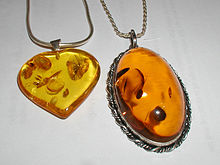
Amber pendants made of modified amber. The oval pendant is 52 by 32 mm (2 by 1.3 inches).
What is Amber?
The gem we call Amber is fossilized tree resin, often mistakenly called fossilized tree sap. The basic difference between these two organic materials is that sap is rather thin, composed of mostly water, and runs deeper in a tree, carrying all of the nutrients the tree needs to live. In contrast, thicker resin runs just under the bark of a tree, and acts as a healing agent should the tree become damaged, blocking any holes or scrapes to prevent fungal disease and/or bugs from entering the tree. Amber is one of few, true organic materials that classify as a gemstone: the others are pearls, certain shells like abalone, jet, ivory, and coral.
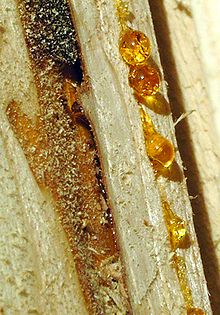
Wood resin, the source of amber
The earliest amber recorded thus far, is from the Carboniferous (coal-bearing) time period, about 320 Million years ago! This rare form of amber is kept for scientific research (so don’t go looking to purchase it). Amber is one of the oldest known materials used to make jewelry. Naturally it is found in a wide variety of colors, ranging from pale yellow to deep cherry red and in rare instances, blue and green! (Note-if you are looking for what is sometimes referred to as “Black Amber,” you really want jet, which is a form of coal.)
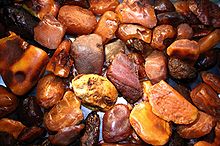
Unpolished amber stones
Amber actually comes in a variety of colors! Amber is a very soft material, scoring a maximum of a 3 on Mohs scale of hardness (some samples are as soft as a 1), so be especially careful with metal pliers when wrapping amber in wire. Burmese amber is among the hardest of ambers at a 3, Baltic is in the middle, and Dominican amber can be as low as 1 on Mohs scale. That’s because Dominican amber is the youngest – at 20 – 40 million years old!
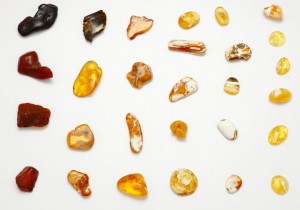
Unique colors of Baltic amber. Polished stones.
Imitation is the best form of flattery:
Amber Imitations
Copal: Being a semi-fossilized, natural hardened resin, copal is the most often used substitute as an inexpensive amber. Often sold as “young” or immature amber (being anywhere from 50 to 1.6 million years old) copal is unstable and liable to deteriorate over time, therefore it is a less suitable as a gemstone-like material. Copal is very valuable though, as it is widely used to make excellent varnish and believe it or not, in Mexico and Central America native Indians burn copal as incense during rituals. (Other popular incense “resins” include frankincense and myrrh.) The easiest way to test for copal vs. amber, is to put a drop of pure acetone in an inconspicuous place on the piece in question. Copal will become sticky very quickly whereas amber will not have any reaction. Beware of copal that is called by unusual names such as Caribbean amber, Chinese amber or Burmite, because copal can be chemically treated to change both the natural color as well as the hardness. Another type of copal that some try to pass for natural amber is called Kauri Gum, from New Zealand.
Vintage Plastics: Bakelite, Celluloid, and their varieties are valuable today because of the history attached to these materials. Mainly used in the 19th century through World War II, most of these early resins contained materials like wood, true amber shavings and rock particles along with unfavorable additions such as asbestos and formaldehyde’s. One of the names used for these amber counterfeits was “African Amber”. My new research on amber imitations also took me to a very interesting page about a vintage product called Faturan, a form of Bakelite that was used to carve prayer beads, until world-wide health implications combined with materials shortage due to World War II stopped the production of this fake amber material.

Synthetic Amber Cabochon made from Resin and Amber Flakes
Modern Plastics: Polyester, Epoxy Resins, and Plexiglas are often made to look like amber. Sometimes copal is covered with an epoxy resin to harden the immature fossil and other times the shavings, chips and broken pieces of real amber are mixed with the resin to form the products known as “pressed” amber and reconstituted or reconstructed amber. Note: “Amberlite™” is not actually an imitation of amber but rather the trademarked name for a type of resin/ion-exchange product developed to remove impurities from water and other substances in the biopharmaceutical industry.
Glass: Although much heavier, cold and more shiny and transparent than natural amber, some vendors still try to pass off glass/silica as amber.
Traditions with Amber:
There are many myths, legends and stories associated with amber. With regards to metaphysical properties, it is most often used to stimulate intellect by opening Sahasrara, the crown chakra. The many natural colors of amber can be also used on the appropriate chakras according to their color. Basically, amber is used as a cleansing stone for both the mind and the body.
Prayer beads and rosaries are often made of amber due to the fact that rubbing amber produces warmth and static electricity, both of which are thought to be beneficial to human health, especially while meditating
Real or Fake:
Although no test is absolutely conclusive, if you have a piece of amber that you think could be very old, real and therefore very expensive, I recommend sending it to an amber expert for proper identification. If you’d like detailed information on each kind of amber authenticity test, here is a page that covers all of them: Amber Tests.
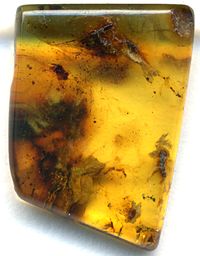
Typical amber specimen with a number of indistinct inclusions
When purchasing amber, ... "
http://www.wirejewelry.com/jewelry-maki ... d187b52794